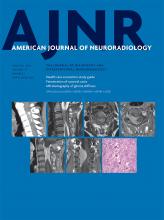Research ArticleExtracranial Vascular
Open Access
Lower Arterial Cross-Sectional Area of Carotid and Vertebral Arteries and Higher Frequency of Secondary Neck Vessels Are Associated with Multiple Sclerosis
P. Belov, D. Jakimovski, J. Krawiecki, C. Magnano, J. Hagemeier, L. Pelizzari, B. Weinstock-Guttman and R. Zivadinov
American Journal of Neuroradiology January 2018, 39 (1) 123-130; DOI: https://doi.org/10.3174/ajnr.A5469
P. Belov
aFrom the Buffalo Neuroimaging Analysis Center, Department of Neurology (P.B., D.J., J.K., C.M., J.H., R.Z.)
D. Jakimovski
aFrom the Buffalo Neuroimaging Analysis Center, Department of Neurology (P.B., D.J., J.K., C.M., J.H., R.Z.)
J. Krawiecki
aFrom the Buffalo Neuroimaging Analysis Center, Department of Neurology (P.B., D.J., J.K., C.M., J.H., R.Z.)
C. Magnano
aFrom the Buffalo Neuroimaging Analysis Center, Department of Neurology (P.B., D.J., J.K., C.M., J.H., R.Z.)
J. Hagemeier
aFrom the Buffalo Neuroimaging Analysis Center, Department of Neurology (P.B., D.J., J.K., C.M., J.H., R.Z.)
L. Pelizzari
dDepartment of Electronics, Information and Bioengineering (L.P.), Politecnico di Milano, Milan, Italy
eFondazione Don Carlo Gnocchi Organizzazione Non Lucrativa di Utilita' Sociae (L.P.), Milan, Italy.
B. Weinstock-Guttman
bJacobs MS Center, Department of Neurology (B.W.-G.)
R. Zivadinov
aFrom the Buffalo Neuroimaging Analysis Center, Department of Neurology (P.B., D.J., J.K., C.M., J.H., R.Z.)
cCenter for Biomedical Imaging at Clinical Translational Science Institute (R.Z.), University at Buffalo, State University of New York, Buffalo, New York

References
- 1.↵
- Lucchinetti CF,
- Bruck W,
- Lassmann H
- 2.↵
- 3.↵
- 4.↵
- 5.↵
- 6.↵
- Kappus N,
- Weinstock-Guttman B,
- Hagemeier J, et al
- 7.↵
- Zivadinov R,
- Weinstock-Guttman B,
- Hashmi K, et al
- 8.↵
- 9.↵
- 10.↵
- 11.↵
- 12.↵
- 13.↵
- 14.↵
- 15.↵
- 16.↵
- 17.↵
- Polman CH,
- Reingold SC,
- Banwell B, et al
- 18.↵
- Chobanian AV,
- Bakris GL,
- Black HR, et al
- 19.↵
- Gisolf J,
- van Lieshout JJ,
- van Heusden K, et al
- 20.↵
- 21.↵
- Allen NB,
- Lichtman JH,
- Cohen HW, et al
- 22.↵
- 23.↵
- 24.↵
- Minagar A,
- Jy W,
- Jimenez JJ, et al
- 25.↵
- 26.↵
- 27.↵
- 28.↵
- 29.↵
- Debernard L,
- Melzer TR,
- Van Stockum S, et al
- 30.↵
- 31.↵
- Lu H,
- Xu F,
- Rodrigue KM, et al
- 32.↵
- Prinster A,
- Quarantelli M,
- Orefice G, et al
- 33.↵
- 34.↵
- Wattjes MP,
- van Oosten BW,
- de Graaf WL, et al
- 35.↵
- McTaggart RA,
- Fischbein NJ,
- Elkins CJ, et al
- 36.↵
- Zaharchuk G,
- Fischbein NJ,
- Rosenberg J, et al
- 37.↵
- 38.↵
- Sethi SK,
- Daugherty AM,
- Gadda G, et al
- 39.↵
- Magnano C,
- Belov P,
- Krawiecki J, et al
- 40.↵
- Koerselman J,
- van der Graaf Y,
- de Jaegere PP, et al
- 41.↵
In this issue
American Journal of Neuroradiology
Vol. 39, Issue 1
1 Jan 2018
Advertisement
P. Belov, D. Jakimovski, J. Krawiecki, C. Magnano, J. Hagemeier, L. Pelizzari, B. Weinstock-Guttman, R. Zivadinov
Lower Arterial Cross-Sectional Area of Carotid and Vertebral Arteries and Higher Frequency of Secondary Neck Vessels Are Associated with Multiple Sclerosis
American Journal of Neuroradiology Jan 2018, 39 (1) 123-130; DOI: 10.3174/ajnr.A5469
0 Responses
Lower Arterial Cross-Sectional Area of Carotid and Vertebral Arteries and Higher Frequency of Secondary Neck Vessels Are Associated with Multiple Sclerosis
P. Belov, D. Jakimovski, J. Krawiecki, C. Magnano, J. Hagemeier, L. Pelizzari, B. Weinstock-Guttman, R. Zivadinov
American Journal of Neuroradiology Jan 2018, 39 (1) 123-130; DOI: 10.3174/ajnr.A5469
Jump to section
Related Articles
Cited By...
This article has not yet been cited by articles in journals that are participating in Crossref Cited-by Linking.
More in this TOC Section
Extracranial Vascular
Similar Articles
Advertisement











